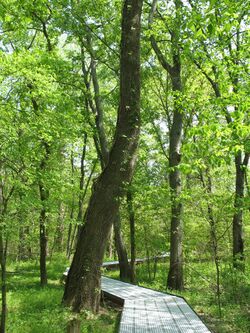Earth:Bottomland hardwood forest

The bottomland hardwood forest is a type of deciduous and evergreen hardwood forest found in broad lowland floodplains along large rivers and lakes in the United States[1] and elsewhere.[2] They are occasionally flooded, which builds up the alluvial soils required for the gum, oak and bald cypress trees that typically grow in this type of biome.[3] The trees often develop unique characteristics to allow submergence, including cypress knees and fluted trunks, but can not survive continuous flooding.[4]
Typical examples of this forest type are found throughout the Gulf Coast states, and along the Mississippi River in the United States. It is estimated there were 24,000,000 acres (97,000 km2) in the region before foresting and farming reduced it to approximately 4,000,000 acres (16,000 km2) today.[5][6]
References
- ↑ "Bottomland Hardwood Forest". Louisiana Department of Wildlife and Fisheries. December 2005. Archived from the original on March 6, 2007. https://web.archive.org/web/20070306105947/http://www.wlf.state.la.us/pdfs/experience/Bottomland%20Hardwood%20Forest.pdf. Retrieved 2009-04-25.
- ↑ "Human Interventions on Wetlands and their Long Term Impacts on Human Well-being a study of Kizilirmak Delta case, Samsun, Turkey". https://open.metu.edu.tr/bitstream/handle/11511/19394/index.pdf.
- ↑ "Bottomland Hardwoods". School of Forest Resources and Conservation at the University of Florida. Archived from the original on 2009-05-27. https://web.archive.org/web/20090527080612/http://www.sfrc.ufl.edu/4h/Ecosystems/Bottomland_Hardwoods/bottomland_hardwoods.html. Retrieved 2009-04-25.
- ↑ "Wetlands: Bottomland Hardwoods". Environmental Protection Agency. https://www.epa.gov/wetlands/bottomland-hardwoods. Retrieved 2018-04-26.
- ↑ "The Big Woods of Arkansas: An Imperiled National Treasure". The Nature Conservancy. https://www.nature.org/ourinitiatives/regions/northamerica/unitedstates/arkansas/ivorybill/big-woods-of-arkansas.xml. Retrieved 2018-04-26.
- ↑ Yin, Yao, et al. “Bottomland Hardwood Forests along the Upper Mississippi River.” Natural Areas Journal, vol. 17, no. 2, 1997, pp. 164–73. JSTOR website Retrieved 6 Jan. 2023.
